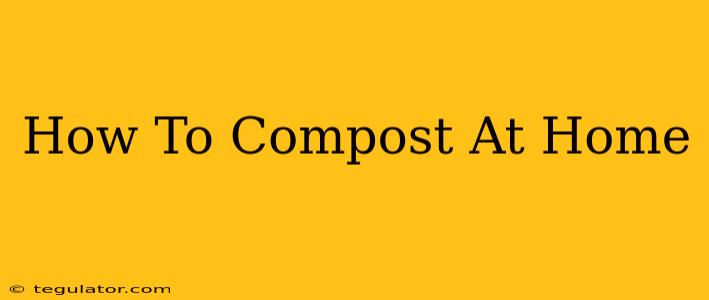Composting at home is a rewarding way to reduce your environmental impact, enrich your garden, and save money on expensive store-bought fertilizers. But where do you start? This comprehensive guide will walk you through everything you need to know about composting at home, from choosing the right method to troubleshooting common problems.
Understanding the Composting Process
At its core, composting is nature's way of recycling organic matter. It's a process of decomposition where microorganisms (bacteria, fungi, etc.) break down organic materials into a nutrient-rich humus, a dark, crumbly substance that’s excellent for your plants. This process requires a balance of "greens" and "browns."
Greens: Nitrogen-Rich Materials
- Food scraps: Fruit and vegetable peels, coffee grounds, tea bags (remove staples), eggshells.
- Grass clippings: Freshly cut grass is ideal.
- Plant trimmings: Herbs, flowers, and leafy greens.
Browns: Carbon-Rich Materials
- Dried leaves: An excellent source of carbon.
- Shredded paper: Newspaper, cardboard (remove tape and labels).
- Wood chips: Small pieces of untreated wood.
- Twigs and small branches: These should be chopped into smaller pieces for faster decomposition.
The ideal ratio is roughly 1:2 (greens to browns), although you can adjust based on the specific materials you're using and the moisture level. Too many greens can lead to foul odors and attract pests, while too many browns will slow down the composting process.
Choosing Your Composting Method
There are several ways to compost at home, each with its own advantages and disadvantages.
1. The Simple Bin Method:
This is the most common and easiest method for beginners. All you need is a container, preferably with ventilation holes, to hold your compost. Regular turning is crucial for aeration and decomposition. Plastic bins, wooden pallets, or even repurposed barrels can work well.
Advantages: Affordable, easy to build or purchase, versatile.
Disadvantages: Requires more manual effort for turning, can be visually unappealing in some setups.
2. The Worm Composting (Vermicomposting) Method:
This method uses red wiggler worms to break down organic matter. It's ideal for smaller spaces, as it requires less volume than traditional composting. Worm composting usually takes place in a bin specifically designed to hold worms and their castings (worm poop, which is a valuable fertilizer).
Advantages: Compact, relatively odorless, produces high-quality worm castings.
Disadvantages: Requires purchasing worms and a specialized bin.
3. Composting in the Garden:
This method involves directly incorporating organic materials into the soil. It’s a great option if you already have an established garden bed. You can simply layer your compostable materials among your plants.
Advantages: Simple, minimal setup required, keeps compost materials close to where they’re needed.
Disadvantages: Not ideal for large volumes of compost, not suitable for all plants.
Essential Tips for Successful Composting:
- Moisture: Maintain a consistently moist environment, like a damp sponge. Too dry, and the process slows; too wet, and it can become anaerobic (smelly).
- Aeration: Regularly turning the compost with a garden fork introduces oxygen, essential for the decomposition process.
- Layer materials: Mix greens and browns in layers to maintain the proper carbon-to-nitrogen ratio.
- Avoid certain materials: Meat, dairy products, oily foods, diseased plants, and pet waste can attract pests and create unpleasant odors, and should be avoided.
- Patience: Composting takes time. Depending on the method and conditions, it can take anywhere from a few weeks to a year for your compost to be ready.
Troubleshooting Common Composting Problems:
- Foul Odor: This usually indicates anaerobic conditions. Turn the compost more frequently and add more brown materials.
- Slow Decomposition: The compost may be too dry or lack sufficient aeration. Add water and turn the pile regularly.
- Pest infestation: Attracted by improperly managed compost. Ensure a proper carbon-to-nitrogen ratio and remove any visible pests.
Harvesting and Using Your Compost
Once your compost is dark, crumbly, and earthy-smelling, it's ready to use! It can be added directly to garden beds, used as a top dressing for lawns, or mixed into potting soil for container plants. Enjoy the fruits of your labor (literally!).
By following these simple steps and tips, you can easily start composting at home and reap the benefits of a more sustainable and productive garden. Happy composting!

